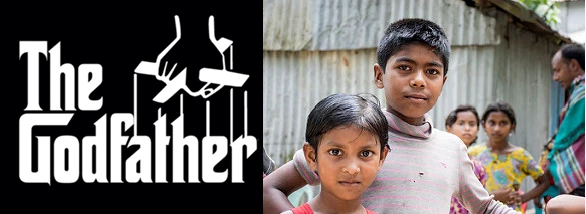In The Godfather II, Vito Corleone chooses his younger son, Michael, instead of his older son, Fredo, as his successor. This decision is based on Michael's intelligence and ability. Fredo, who is considered weak, is dismissed to do more menial tasks for the family. This has huge implications for Michael, Fredo, and the Corleone saga.
CC (The Godfather) Image courtesy of Insomnia Cured Here on Flickr
What makes parents decide to "invest" in one child over another? In economics, a key idea is that parents either reinforce or compensate for children’s endowments, such as health or intelligence. They reinforce by investing more in the human capital of their better-endowed children. Or they compensate by investing more in their worse-endowed children to reduce inequality among siblings. The core notion is : either parents are striving for equity (the compensating strategy) or efficiency (the reinforcing strategy of Vito Corleone).
Are parents benevolent social planners or ruthless investment bankers?
Research suggests that parents reinforce initial endowments by investing more in “higher quality” children. However, in some studies, we do see evidence that parents compensate.
The answer may depend, for instance, on income—poor parents reinforce to maximize returns on investments, while well-off parents have the luxury of compensating. Even within poor families, parental strategy may be multi-pronged. In Ethiopia and China, parents are more concerned with equity when it comes to health inputs (where it might be a question of child survival), so they compensate for endowment differences. For educational inputs, on the other hand, parents appear motivated by return maximization so they reinforce endowment differences.
Return maximization for education investments is particularly plausible in developing countries. Parents faced with limited resources must make difficult choices even in terms of primary schooling across children. Parental resources for education are generally not equally distributed across siblings. Instead parents favor children who perform better and/or are more likely to advance to higher education, where labor market returns are strongest. In other words, parents focus on getting the most talented children through higher levels of education rather than spreading some education evenly across all their children.
In Burkina Faso, for example, only 27% of households enroll all their children in school. A child with one standard deviation higher ability compared to the average ability of his siblings is 30% more likely to be enrolled. On the other hand, a child with a higher-ability sibling is 15% less likely to be enrolled. In Ethiopia, when parents are asked what criteria they would use to send only one child to school, their most common response was ‘the child who was good at schoolwork. A separate study in Ethiopia also showed that children with higher cognitive ability were less likely to be engaged in child labor than their lower ability siblings. In the Philippines, a child’s perceived educational ability was a key determinant of whether parents chose to keep the child in school or engaged in child labor. Even in the United States, a study on twins showed that parents may provide more cognitive stimulation to the sibling with higher cognitive ability.
[As a sidebar: parents, especially less educated parents, may have trouble detecting the better performing child. In Malawi, one third of parents are mistaken about which child is higher-performing].
Parents believe that by focusing their education resources on their brightest children, they will maximize rewards. But is this always the right strategy? This depends on what parents expect in terms of education ‘rewards’ and whether these expectations align with reality.
Banerjee and Duflo argue that in some contexts, parents see education as a lottery instead of a safe investment. The ‘lottery’ is a government or office job. In Madagascar, 70% of interviewed parents thought that a secondary school graduate would get a government job. In reality, only about 33% of secondary graduates actually get government jobs in the country. These parents believe that the returns from each year of secondary schooling (17%) are significantly higher than returns from each year of primary schooling (0.4%). Therefore, given financial constraints, it might make more sense to focus on sending the brightest child to secondary school rather than sending all children to primary school.
This idea is misguided because each additional year of schooling provides a proportional increase in income, even in the non-formal job market. In addition, there are many non-monetary benefits to education, including better health and living conditions. So, the rational choice might in fact be to equally distribute resources, rather than focus resources on one child. In other words, return maximization might occur through a compensatory rather than reinforcing strategy.
What prevents them from making optimal decisions is imperfect information on the returns to education. Hence, it might be crucial to provide accurate information on education returns to parents to correct for inaccurate perceptions so that, whether reinforcing or compensating, parents can make the best possible choices for their children.
But all said and done, Fredo deserved to be “stepped over.”
This post is part of a blog series titled #HumanEcon by Shwetlena Sabarwal. Other posts can be found here.




Join the Conversation